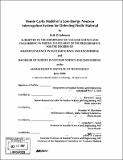Monte Carlo model of a low-energy neutron interrogation system for detecting fissile material
Author(s)
Johnson, Erik D., Ph. D. Massachusetts Institute of Technology
DownloadFull printable version (11.41Mb)
Other Contributors
Massachusetts Institute of Technology. Dept. of Nuclear Science and Engineering.
Advisor
Richard C. Lanza.
Terms of use
Metadata
Show full item recordAbstract
(cont.) Further MCNP simulations of the neutron source impinging on cargo containers suggest that this technique can respond, as expected, qualitatively differently to containers containing SNM from containers that do not. Containers that contain small amounts of fissile isotopes as in the case of a few grams of uranium-235 in a kilogram of depleted uranium will also respond to this method but much more weakly. The system as proposed is viable and further simulation and experimental work will elucidate the behavior of this system under a wide range of cargo environments. The undeniable threat of nuclear terrorism presents an opportunity for innovation in developing active interrogation technology. The proposed system aims to detect the smuggling of special nuclear material (SNM) in maritime containers. Identifying the importation of SNM will be instrumental in protecting the American public from a nuclear terrorist attack made possible by the construction of a weapon with fissile material from abroad. The proposed system uses a directionally-biased beam of low-energy neutrons (60 - 100 keV) generated from a 7Li(p,n)7Be reaction run near threshold. These neutrons are directed towards a cargo container of unknown composition. If SNM is present in the container and the neutrons can reach it, high-energy fission neutrons will be detectable outside the cargo container. MCNP models indicate that even low-energy neutrons will be able to penetrate through reasonable amounts of material likely to be encountered in cargo environments. The only major exception is hydrogenous material, which could alter the radiation signature. The presence of shielding material may further alter these results. Small amounts of shielding that is hydrogenous will thermalize incident neutrons and raise the likelihood of generating fissions. An abundance of shielding material could mask the presence of fissile material but will also result in changes in the induced gamma energy spectrum and greatly increase the flux of thermal neutrons even outside the cargo container. Still, this material would not be resistant to other radiological techniques and the presence of an abundance of hydrogen will be evident and potentially raise suspicion in and of itself.
Description
Includes bibliographical references (p. 66-67). Thesis (S.M. and S.B.)--Massachusetts Institute of Technology, Dept. of Nuclear Science and Engineering, 2006.
Date issued
2006Department
Massachusetts Institute of Technology. Department of Nuclear Science and EngineeringPublisher
Massachusetts Institute of Technology
Keywords
Nuclear Science and Engineering.